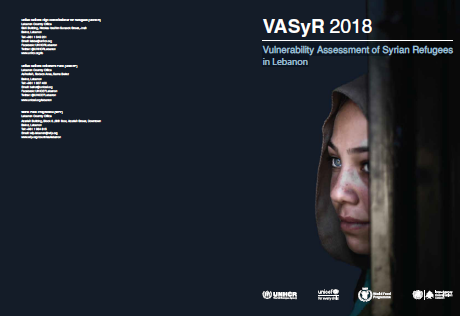Vulnerability Assessment of Syrian Refugees in Lebanon (VASyR 2018)
 |
rapport Dec 2018 ; 205 pages
Ed. PAM - Beirut UNICEF - New York UNICEF - Beirut UNHCR - Beirut
Téléchargeable sous format: PdF
Téléchargeable chez l'éditeur
Abstract:
Now in its sixth year, the Vulnerability Assessment of Syrian Refugees in Lebanon (VASyR) assesses a representative sample of Syrian refugee families to identify changes and trends in their situation. The Government of Lebanon (GoL) estimates that the country hosts 1.5 million Syrian refugees who have fled their country’s conflict since 2011 (including nearly one million registered with UNHCR as of end of September 2018). The Syrian refugee population in Lebanon remains the largest concentration of refugees per capita and the fourth largest refugee population in the world.
Since the beginning of the crisis, both the people and the Government of Lebanon have responded with generosity and tolerance. A robust response has been mounted in partnership with the international community, helping to avert the dire consequences and support positive outcomes for Syrian refugees.
As noted in previous years, the conflict in Syria has exacerbated pre-existing development constraints in Lebanon. Since 2015, annual funding was in excess of US$ 1 billion per year, while needs approached and then exceeded US$2 billion. In 2018, funding requirements for adequate support to Syrian refugees in Lebanon was estimated at US$ 2.291 billion. As of 30 September 2018, those needs were only one third funded. Insufficient funding threatens assistance and protection, safe shelter and effective education, as well as constraining the ability to adequately support the most vulnerable refugees, including women, children and individuals with disabilities.
The contents of this report, jointly issued by the United Nations High Commissioner for Refugees (UNHCR), the United Nations Children’s Fund (UNICEF) and the World Food Programme (WFP), demonstrate that despite the large scale assistance and while the efforts of Lebanon and its partners have resulted in improvements in economic vulnerability and stabilization in education, food security and some improvements in the situation for women, girls and female-headed households, Syrian refugees still remain very vulnerable. The economic context remains precarious and the protection needs persist.
Despite improvements in economic vulnerability, over half of Syrian refugee households had expenditures below the Survival Minimum Expenditure Basket of US$ 2.90 per person per day, unable to meet survival needs of food, health and shelter, and 69% of households remained below the poverty line. Notwithstanding achievements in food security, one in three Syrian refugee households remain moderately to severely food insecure.
Continued fine-tuning of programming based on targeting, improved livelihood opportunities and a significant injection of funding will all be essential to build on successes and address shortcomings.
Contents:
Introduction
1. Methodology
2. Demographics
3. Protection
4. Shelter
5. Water, Sanitation and Hygiene (WASH)
6. Education
7. Health
8. Food Consumption
9. Economic Vulnerability
10. Livelihoods and Income
11. Coping Strategies
12. Food Security
13. Assistance and Household Assets
14. Gender
Conclusions and Recommendations
Public-Cible:
Mot clef: |
Pays concerné: |
Editeurs/Diffuseurs: |
|
PAM
-
Programme Alimentaire Mondial - Beirut - Liban |
UNICEF - New York - Etats Unis |
UNICEF
-
United Nations Children's Fund - Beirut - Liban |
UNHCR
-
United Nations High Commissioner for Refugees - Beirut - Liban |
En cas de lien brisé, nous le mentionner à communication@pseau.org